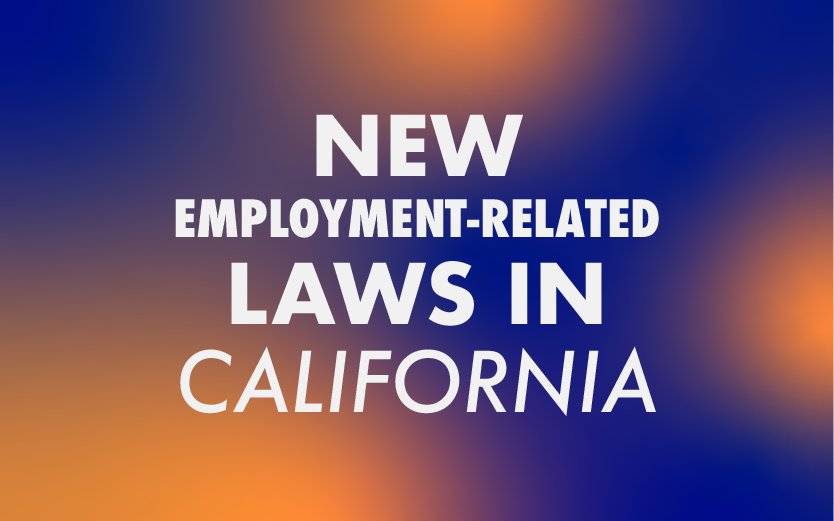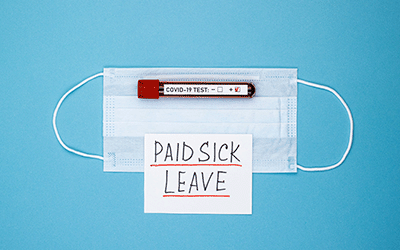With the new year have come a slew of new laws impacting employers throughout California. Here’s an overview:
MINIMUM WAGE
Minimum wage continues to increase in California.
Beginning on January 1, all employees in the Golden State are required to be paid at least $15.50/hour. As of the summer of 2022, the minimum wage is even higher in certain cities, as follows:
- Los Angeles County: $15.96/hour
- City of Los Angeles: $16.04/hour and $18.86/hour for hotel employees working in properties with 60 or more rooms
- Malibu: $15.96/hour
- Pasadena: $16.11/hour
- Santa Monica: $16.96/hour and $18.17 for hotel employees
- West Hollywood: $17.50/hour (businesses with 50 or more employees), $17.00/hour (businesses with fewer than 50 employees) and $18.35/hour for hotel employees (starting July 2023, employees in all three categories must be paid at least $18.86)
Note that employers should remain alert for further updates as many city minimum wage increases occur mid-year. Also, other cities and industries, not referenced above, may also have their own minimum wages.
LEAVE LAWS
The scope of bereavement leave rights has been expanded.
Bereavement is now a protected leave category in California. Employees are permitted to take up to five days of bereavement leave for the death of a family member. This leave may be unpaid, but employees can avail themselves to available vacation, personal leave, accrued sick leave, or compensatory time off.
Employees may take leave to care for a “designated person.”
Additionally, leave has been expanded so that an employee can care for “designated persons” (defined as any individual related by blood or whose association with the employee is the equivalent of a family relationship)—this under the California Family Rights Act. Employees may identify one “designated person” every 12 months.
NON-DISCRIMINATION LAWS
California identifies a new protection for reproductive health decision-making.
Under the California Fair Employment and Housing Act, it is now unlawful to discriminate against an individual in hiring or employment decisions based on “reproductive health decision-making,” which includes use of a particular drug or medical service.
PAY TRANSPARENCY
Employers will face heightened pay transparency requirements.
As of January 1, employers are required to make additional disclosures on pay data reports and provide pay ranges on job postings. This new mandate impacts almost all employers and there will be large civil penalties for non-compliance, up to $10,000 per violation.
Pay scale disclosure requirements mean employers must (1) include the applicable pay scale on all job postings; (2) not use salary history as a factor in employment decisions; and (3) maintain records of job title and wage rate information for the duration of an employee's employment, plus an additional three years.
For employers with 100 or more employees, annual pay data reports must be submitted (this year by May 10) to the California Civil Rights Department setting forth the number of employees by race, ethnicity and sex, along with information on these employees’ earnings, pay rate and hours worked.
EMPLOYEE PRIVACY
Employee information is placed under heightened protection.
Under the California Privacy Rights Act, certain employers now have increased obligations to ensure protection of employees’ information in the same way they have been expected to protect consumer data. The CPRA applies to employers that either (1) had annual gross revenues in excess of $25 million (as of January 1 of the calendar year); (2) annually buy, sell or share the personal information of 100,000 or more consumers or households; or (3) derive 50 percent or more of its annual revenues from selling or sharing consumers’ personal information.
Under the CPRA, “personal information” is “information that identifies, relates to, describes, is reasonably capable of being associated with, or could reasonably be linked, directly or indirectly, with a particular consumer or household,” including professional or employment-related information.
Key employee rights under the CPRA include (1) notice of collection of personal information; (2) the right to delete and correct personal information; (3) the right to know what information is sold and shared; (4) the right to opt out of the sale of personal information; and (5) the right to restrict uses of personal information.
WORKPLACE SAFETY
Prohibition of retaliation for failure to work during an emergency condition.
As of January 1, employers cannot retaliate against employees who refuse to report for work or leave work during an “emergency condition” (which includes conditions created by natural forces or a criminal act, but not a health pandemic) if there is a reasonable belief that the workplace is unsafe. Likewise, employers are now prohibited from stopping employees from accessing their mobile devices to seek emergency services, assess safety concerns or communicate others to confirm their safety.
NOTICE REQUIREMENTS
Cal-WARN notice requirements expand to call centers.
Existing notice requirements under Cal-WARN have been expanded to call center employers that intend to relocate their call center(s) or one or more operating units. The Labor Commission is authorized to enforce this law.
COVID-19 UPDATES
Notice requirements for outbreaks are now more limited.
Employers are no longer required to notify a local public health agency in the event of a COVID-19 outbreak. However, employers must continue to notify employees of potential exposure. Previously, employers had to provide written notice to all employees the day of exposure. Now, employers must simply display a notice in a prominent place for 15 days.
Supplemental paid sick leave expires.
Employer requirements to provide COVID-19 Supplemental Paid Sick Leave expired on December 31, 2022. Employees on leave at the time of expiration may finish taking the amount of leave then available. Having said that, certain cities and counties have their own SPSL policies that may still be in effect.
COVID-19 remains an “injury” for purposes of workers’ compensation.
Under existing law that was set to expire in January 2023, illness or death from COVID-19 is an “injury” for purposes of workers’ compensation and there is a rebuttable presumption that such an injury has arisen in the course of employment, making it compensable. Under AB 1751, this law has been extended through January 2024.
POTENTIAL ARBITRATION UPDATES
California Supreme Court may walk back requirement to arbitrate representative actions.
Since the U.S. Supreme Court’s decision in Viking River Cruises v. Moriana, representative actions brought pursuant to the California Private Attorneys General Act (PAGA) are now subject to individual arbitration. Nevertheless, in June 2022, the California Supreme Court granted review in Adolph v. Uber Technologies, which review will likely examine whether an employer may compel the arbitration of PAGA claims under California law. We will continue to monitor the Adolph case and report back when a decision has been issued.
FAIR WORK WEEK
Some employers may be faced with even more burdens around employee scheduling and pay.
We await Mayor Karen Bass’s signature enacting the Fair Work Week Ordinance. If it becomes law as expected, retail businesses in Los Angeles or establishments employing 300 or more employees worldwide will face increased obligations around employee scheduling and pay.
Pursuant to the law if enacted, (1) employers will have to provide a good faith estimate of their would-be employees’ work schedules before hiring; (2) employees can request preference for work hours and location; (3) employers must furnish written notice of an employee’s schedule at least 14 days in advance; (4) deviations from the provided schedule could result in overtime, or even double time pay; (5) employers will need to offer existing work to current employees before hiring additional workers; (6) employees cannot be required to find coverage for their shifts; (7) employees cannot be required to work two shifts with less than 10 hours between them; and (8) employers must retain records for at least three years, including work schedules, copies of written offers to employees for additional work, and other correspondence with employees regarding scheduling
If approved, the Ordinance is to take effect in April 2023, it will not be subject to waiver, and violations will result in civil penalties up to $500 per infraction. Not only that, employees will also have a private right of action in the event of an alleged infraction.
WEHO PAID TIME OFF
Sick leave for West Hollywood employees.
As has been the case since July 2022, employers in West Hollywood are required to provide full-time employees with at least 96 paid hours each year for sick leave, vacation or personal necessity, plus a minimum of 80 hours of unpaid sick time. Part-time employees must accrue paid time off in proportional increments, and once accrued, their paid time off must carry over, though it can be capped at 192 hours. Unused accrued unpaid time off must carry over as well but can be capped at 80 hours.
HOTEL INDUSTRY SPECIFIC LAWS
Increased requirements on hotels to prevent human trafficking.
Hotel employers continue to be required to provide staff with at least 20 minutes of training on how to recognize human trafficking. On top of this, hotel operators are now subject to civil penalties if a supervisory employee “knew of or acted with reckless disregard of the activity constituting sex trafficking” within the hotel and failed to inform a proper authority (e.g., law enforcement or the National Human Trafficking Hotline).
Increased protection for hotel workers in the City of Los Angeles.
In Los Angeles, the Hotel Worker Protection Ordinance became effective last August. The law is meant to ensure hotel workers are equipped with personal security devices and supported in their ability to report criminal and threatening behavior. It also contains provisions to ensure fair compensation and deter overly burdensome work. And while the application of certain provisions is dependent upon the size of a given hotel, the Ordinance creates at least some new requirements for all hotels in Los Angeles.
Key provisions of the law include (1) providing certain workers with a personal security device; (2) staffing a position to respond to distress calls; (3) conducting trainings around security measures; (4) providing notice to staff and guests of these safety policies; (5) limiting mandatory overtime; (6) record retention; (6) limiting the ability to implement programs not to clean or sanitize rooms daily; and (7) limiting workload for room attendants.
West Hollywood enacted a similar law—the Hotel Worker Protection Ordinance—that also became effective in 2022. As such, hotels in that city should continue to ensure compliance with the Ordinance by (1) protecting hotel workers from violent or threatening conduct; (2) providing fair compensation depending upon workload; (3) ensuring the right of hotel worker recall and retention; and (4) providing public housing training.
EMPLOYER ACTION ITEMS
In light of all of the new laws referenced above, employers would be wise to do all of the following right away:
- Review base salaries for all exempt employees to ensure they meet the applicable salary requirements and confirm that non-exempt employees are being paid at least the applicable minimum wage.
- Update employee handbooks to reflect changes in the law.
- Create pay scales for all employee positions to be used in job posting or upon request by an employee.
- Review city- and industry-specific laws to ensure compliance.
- Work with those responsible for payroll and legal counsel to meet the May 10 deadline for California’s pay data reporting requirement, including aggregating pay data by position and protected characteristic.
Of course, the employment team at Michelman & Robinson, LLP is always available to answer your employment-related questions.
This blog post is not offered, and should not be relied on, as legal advice. You should consult an attorney for advice in specific situations.










